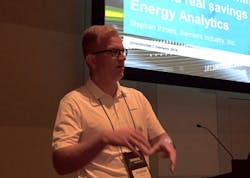Prior to the era of Big Data and the Internet of Things, sustainability was probably the hottest industry trend. Though the buzz around sustainability has largely faded, the trend itself did not disappear, as seen in the results of a recent Automation World reader survey. Instead it has morphed into a common component of industrial business operations—particular the energy efficiency aspects.
One of the more intriguing aspects of the Automation World reader survey on sustainability mentioned above is that, despite a heavy focus by industrial companies on energy efficiency, 82 percent of respondents said their companies do not use software tools for energy management. The likely reason is that such energy management software tools have been on the expensive side—leading some users to search out other means of energy efficiency cost savings. But cloud-based, pay-per-use systems could soon change that scenario.
Evidence of this was on display at the 2016 Siemens Automation Summit in a presentation by Stephan Ihmels, business development manager at Siemens, who explained how Siemens is using its own MindSphere-based Energy Analyzer app to improve operations in its own plants.
Read more about MindSphere in this companion report from the 2016 Siemens Automation Summit.
Deployed at a Siemens Control Components and Systems Engineering facility in the Chicago area (originally built in 1968 as an Allis-Chalmers switchboard plant), the Energy Analyzer has already enabled a hard cost savings of $70,000 per year, demonstrating payback for the project in less than a year.
Though not a particularly energy intensive plant—with annual energy spending in the $500,000 neighborhood and $100,000 annual spend on nitrogen and water—the Siemens Chicago plant serves as a good example of how such data analytics services can transform industrial companies of all sizes.
Having determined that the initial project focus for the Energy Analyzer application at this plant would be on production line electricity consumption, gas consumption by furnaces, and compressed air optimization, Ihmels said the goal of achieving at least a 10 percent reduction in overall energy use was set.
Using Energy Analyzer, Siemens discovered that 36 percent of the facility’s compressed air consumption was caused by leaks. Addressing these leak issues resulted in a nearly $25,000 annual savings for the plant.
The plant also found that 14.4 percent of its electricity use took place during non-productive hours. Fixing that issue resulted in $45,000 annual savings for the plant, according to Ihmels.
Ihmels said that implementation of the Energy Analyzer project—from identification of metering points to installation of metering devices—was completed in about six weeks. It then took about six months to complete the initial energy use analysis with recommendations for improvements. He pointed out that use of Energy Analyzer is not a one-and-done application, instead it is a continuous improvement process that adapts with changing operating parameters and provides new recommendations. As a result, energy savings identification will be an ongoing process for the plant, with the potential to further increase the ROI.
About the Author
David Greenfield, editor in chief
Editor in Chief

Leaders relevant to this article:
